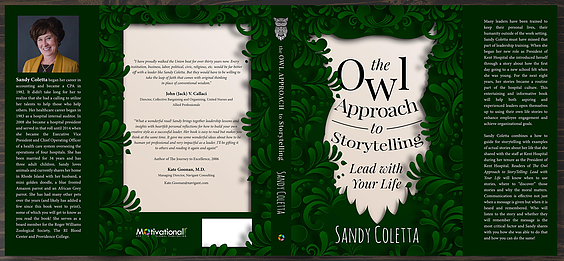The power of storytelling has become one of today’s hot topics in leadership. It can be used as a means of reaching out and connecting, inspiring action and clear understanding of important messages. In her new book, “The Owl Approach to Storytelling: Lead with Your Life”, Sandy Coletta, creates a great “how to guide “for storytelling.
Sandy Coletta began her career in accounting and became a CPA in 1982. It didn’t take her long to realize that one of her many talents was to help those in leadership positions. She quickly saw how her own personal storytelling helped increase employee engagement and achieve organizational goals.
I was recently given a copy of the book to review. As a regular reader, I am always looking for the next book that entertains or adds value. I even have a list of the next books that I intend to read. When I was approached about reviewing “The Owl Approach to Storytelling”, I had put it on my sometime read list. I recently started reading it and the only thing that I regret is that I didn’t read it sooner.
It was a great read. Filled with multiple stories and examples that help inspire your own creative storytelling juices. I have always tried to include stories as a leader to help get my message across or to motivate action on projects. It is easy to see how well crafted stories work so well. This book helped guide me with my future storytelling and even gave me ideas on how to better restructure my current stories. I have no doubt it will help me become a better story teller.
Sandy takes every day leadership examples and shares how the power of storytelling can help. In her chapter, “They see you, but do they know you”? Sandy writes about the unscheduled pop-in and pop-out visit approach. Something that I have used several times in retail to gain a clear understanding of how the store’s performing in a real life setting, without the preparation before an announced visit. She then challenges the reader on how these types of visits may take away from the leader connecting with his team.
There are situations in which we as leaders can utilize our own personal stories to enhance the distribution of the message. The honest and forthright stories shared in this book helps start the reader on his own path of discovering his own stories. Sandy’s stories provide a great guide and starting point to this journey.
The book also shares different themes and types of stories for a variety of situations. There are stories of successes and stories of failures. Joyous moments and Raw moments. How you choose to tell your story can make a huge impact in increasing your team’s employee engagement and delivering results.
I end this review with a snippet of Sandy’s advice on how to tell painful stories that can teach a powerful lesson.
“When you think about your stories, for some of you, the anger or the negativity of your experience may lead you to want to share that perspective. I encourage you to write it for yourself, to find a way to release it for yourself and your own well-being, but as you write as a leader, as you seek to inspire, find the half full version of your challenges and share that instead.”
Have you read the book? Share your thoughts and comments below.

